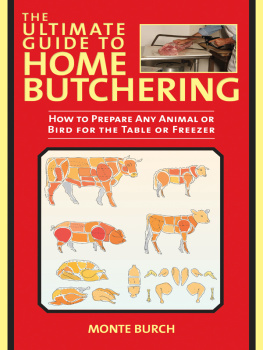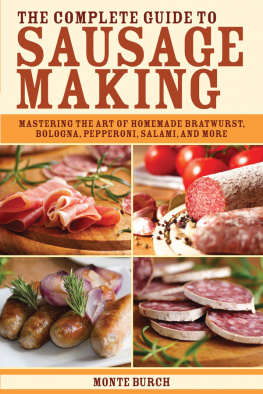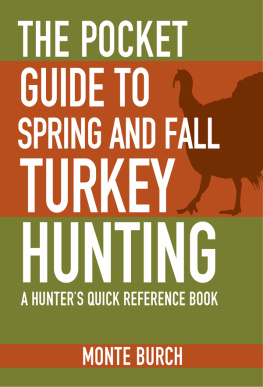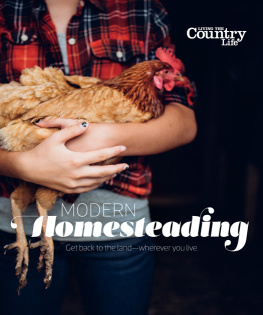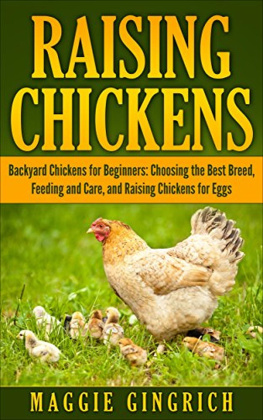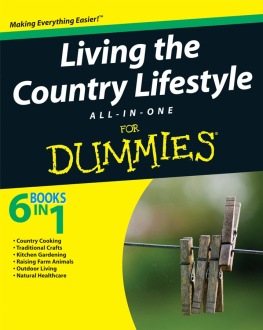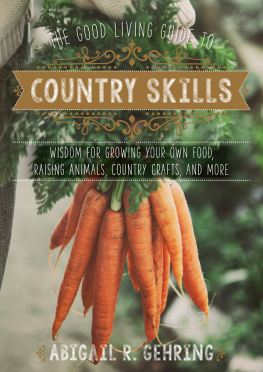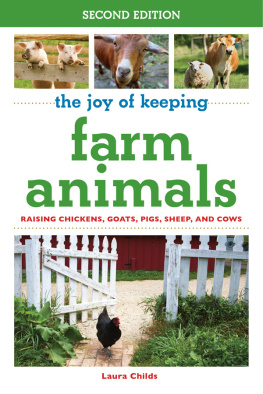Cattle were and still are a very important part of many farms and ranches. Raising cattle can consist of five different operations: backgrounding, or raising calves to feeder size; feedlot feeders; cow/calf herds; simply raising a calf for beef; or keeping a family milk cow. (We wont discuss dairies because theyve become big operations.) In the old days, farmers quite often raised a few cattle from birth to slaughter, slaughtering for their family use and selling off the excess. The family dairy cow was also used to produce the family beef. These days many farms and ranches specialize in the various operations. Beef cattle are well suited to farms that have adequate amounts of forage and roughage. The amount needed depends on the number of animals and the operations involved.
Cattle Breeds
The first question is whether to raise purebred or grade cattle. If you intend to produce breeding stock you may choose to raise purebreds. This requires a higher initial investment, and quite a bit of work in maintaining registration papers and records. For the farmer raising just a few head, however, the profits can be higher than with grade cattle. If you intend to produce feeder calves for sale, or finish calves out yourselves, you will probably wish to purchase grade cattle. Regardless, it takes the same amount of land to produce a good cow as a poor cow, my granddad used to say.
Choosing a breed for a purebred herd is mostly a matter of choice. In my grandfathers day only a handful of beef cattle breeds were available. These days the number has proliferated. Each breed has unique requirements and produce different types of animals.
Grade cattle can be of mixed breeds or, preferably, a three-way cross, which produces animals with the greatest vigor and, with luck, the benefits of each of the crosses. For example, an Angus cow might be bred to a Polled Hereford bull to produce a black-baldy cow. The cow might then be bred to a black Limousin bull to produce a black-baldy calf.
Purchasing
The first step is to purchase breeding stock. Several options include a heifer calf, a bred heifer, an open heifer ready to breed, or a mature cow. A heifer calf requires the least initial investment, but requires additional cost in raising to breeding age. It will normally take more than two years for you to realize any income from your investment. An open heifer is a bit more costly in initial investment, but less cost in the time it takes to realize the investment. You will also have to own or rent a bull or utilize artificial insemination. A bred heifer eliminates the immediate need for breeding. A mature cow allows the quickest return on your investment. The best choice in a mature cow is either a cow ready to calf within three or four months or a cow with a calf by her side. Sometimes you can purchase a bred cow with a calf at her side, but this is also the most expensive initial investment.
Make sure you get the best you can afford. When purchasing mature cows, youre sometimes actually buying someone elses culls. Its also important to purchase a cow of the right age. Most beef cows reach maximum production in seven years, with the most productive years between four and nine. Some cows can produce at fourteen years of age or older. If possible, check the calving records. A good beef cow will produce a calf every eleven to twelve months.
Although each breed has different conformations, some general rules can be followed for all of them. For the most part, the body should be broad and deep and moderately low set. The top line should be straight and the flanks full. Appearance should be smooth. Fleshing should be ample, considering breeding performance, age, and feeding level. Females should have excellent mothering abilities including a sound, correct udder and teats. Bulls should have a pronounced masculinity, including a moderately swollen neck. They should also have a correctly placed sheath and no scrotal faults. Semen tests and scrotal measurements are also important.
CATTLE ARE ONE OF THE MORE POPULAR LIVESTOCK. THEY DONT TAKE AS MUCH WORK AS SOME LIVESTOCK, BUT THEY DO REQUIRE MORE LAND AND FEED.
Whichever breed you purchase, make sure the individual animal is in good health. Within thirty days of purchase, the animals should be tested and found free of brucellosis (Bangs disease or infectious abortion), leptospirosis (a bacterial disease), and tuberculosis. Purchase only from reputable breeders.
Feeding
Different types of animals and animals raised for different purposes have different feed requirements. Feeding may be for maintenance, growth, fattening, lactation, or pregnancy. Pasture forage is the main key to animal feeding. Depending on soil fertility and forage species, from one to five acres of pasture are required for each cow. The pasture should provide adequate grazing for nine months or longer. A mineral mix and salt should also be kept available at all times. Winter requires supplemental feeding. Grass hays make up the bulk of winter feed. Make sure the hay is of good quality. Normally, one-third ton of hay is required per cow per month. The total amount of hay required, however, depends on the length of the season and the quality of the hay. If the hay doesnt provide adequate protein, you may have to supplement with a protein such as cottonseed meal, soybean meal, or a commercial protein supplement. Silage may also be fed, but it may tend to overfatten older cows.
Herd Health
Its important to control diseases and parasites, both internally and externally. Your vet is the best tool for setting up a total herd health program suited to your particular needs. Insects such as flies, lice, and ticks can be controlled with several tactics including a high-pressure sprayer and insecticides, backrubs or dust bags, and cattle insecticides. The latter should be placed at points frequented by the animals. Near a water source is an excellent location.
Breeding
Grouping calves in a sixty- to ninety-day calving period allows for better herd management, and a more uniform calf crop, with higher market values. Do not run a bull with the herd all year. Some cattlemen prefer spring calving; others prefer fall calving. Spring calves require less harvested feed, such as hay, and are normally sold in the fall. Those born in January or February should have some sort of shelter to prevent chilling and freezing. I like to split the herd with calving in both periods. Its a bit more work, but creates a wider range of ages of market animals.
Calving
Make sure you mark the expected calving dates on your calendar. Then begin watching the cows carefully a few days before the expected calving dates. A sign of upcoming calving is a cow that begins to stay away from the herd. Her udder will begin to swell. Her vulva will become enlarged, and the area near the tail head and pin bones will shrink. First calf heifers may have more difficulty than mature cows and should be watched very carefully. A small pasture near the house is the ideal location for the herd ready for calving.
A calf is normally delivered head and front feet first. Several factors may cause a difficult delivery, including a small pelvic opening in the cow, calves having unusually large heads and shoulders, and a posterior or backward delivery. Under normal calving, no assistance is needed. If the delivery hasnt been made within two hours of labor, you should call a veterinarian or experienced cattleman.
Once the calf is delivered, clear any membrane from around its nostrils. If the delivery has been difficult and long, hold its head down immediately upon birth. Holding the calfs head down will clear fluids from the nasal passages and throat. Even a calf that appears dead can sometimes be revived with artificial respiration.


